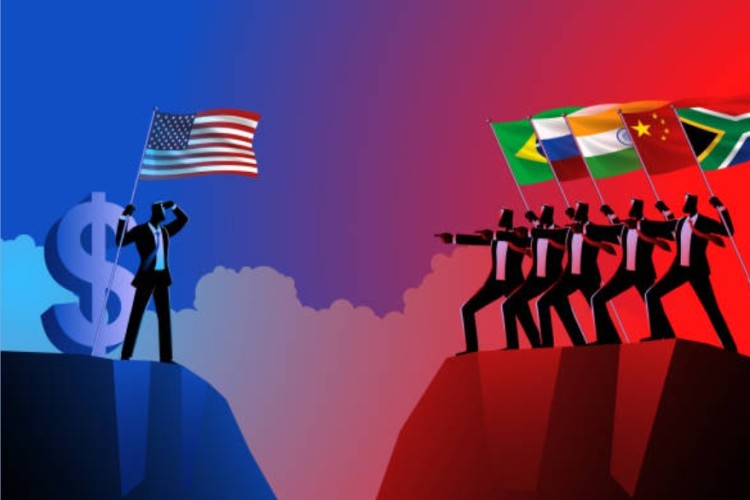
Trump tariffs and BRICS: US President Donald Trump’s latest warning—a 10% tariff on what he called un-American BRICS countries—has reignited global concern about escalating trade wars. The provocation followed the July 6–7 BRICS summit in Rio de Janeiro, where leaders issued a veiled critique of protectionist policies and military interventions, including those in Iran. Trump’s response drew sharp reactions from China, Russia, and South Africa. Brazilian President Lula da Silva minced no words, saying the world doesn’t want “an emperor who lashes out over the internet.”
Despite China’s insistence that BRICS is not a confrontational bloc and targets no third party, the group’s joint declaration hinted otherwise. Without taking names, it flagged tariff hikes as disruptive, anti-WTO, and destabilising to global trade and supply chains. The section titled “Strengthening Multilateralism and Reforming Global Governance” unmistakably referred to Washington’s trade policy. Prime Minister Narendra Modi, along with the expanded BRICS grouping that now includes Egypt, Ethiopia, Iran, UAE—and from 2025, Indonesia—joined in articulating this position.
READ | India’s nuclear energy bet gets a second wind
Escalation amid fragile global recovery
Trump’s retaliatory impulse was swift. Without clarifying what qualifies as anti-American policy, he threatened tariffs against any country aligning with BRICS’ trade positions. He even went further—proposing a 200% tariff on imported pharmaceutical drugs and a 50% duty on copper, aligning it with existing tariffs on steel and aluminium.
These announcements come as the administration ends a 90-day pause, with new tariffs set to kick in on August 1. The logic appears to be simple: economic muscle flexed through unilateral tariffs. But the costs are complex and uneven.
Domestic and global blowback
While the intent may be to punish rival economies, the blowback is inevitable. Tariffs raise import costs, much of which get passed on to US consumers. Economists warn that trade deflection—goods diverted from the US to other markets—can stir protectionist sentiment elsewhere. This, in turn, could prompt retaliatory tariffs on US exports, including services and technology.
Foreign governments are already discussing taxes on American digital services. A stronger dollar, if it results from capital flight to the US, will only make American goods more expensive abroad—hurting exporters further. With the US accounting for roughly 12% of global trade, the remaining 88% might not bypass America entirely, but could increasingly reduce dependence.
BRICS and US-centric trade
BRICS’ emphasis on multilateralism and alternative trade routes—especially through the Belt and Road Initiative and newer blocs involving ASEAN—suggests a strategic shift. Full decoupling from the US is unrealistic, but partial realignment is underway.
China, for example, has been quietly reducing its holdings of US Treasury bonds and increasing gold reserves. This signals a longer-term hedging strategy against weaponised finance. Other BRICS countries, too, are exploring settlement mechanisms that reduce dollar dominance.
Legal and institutional pushback
There is also legal turbulence at home. In May 2025, the US Court of International Trade ruled some of Trump’s IEEPA-based tariffs illegal, though appeals have delayed enforcement. Civil society groups, such as the New Civil Liberties Alliance, have launched fresh legal challenges to presidential tariff powers, questioning their scope and constitutionality.
The uncertainty has consequences. According to the Economic Policy Uncertainty Index, policy ambiguity hit a post-COVID peak in March 2025, slashing business investment by an estimated 4.4%. As some economists put it, the “madman strategy”—random, aggressive, and opaque—may rattle rivals but ultimately depress domestic growth.
Trump tariffs: A risky game with global consequences
Trump’s assumption that unilateral tariffs bring unambiguous leverage ignores a shifting geopolitical landscape. As BRICS deepens trade ties and rallies other middle powers around a WTO-based order, Washington’s go-it-alone path may provoke global fragmentation. If the US triggers retaliation, it may find itself more isolated than feared.
Even within the US, criticism is mounting. Economists and business leaders alike call the tariff spree “a slow-motion crash.” They argue that the long-term damage—rising consumer prices, stalled investment, and geopolitical backlash—will outweigh any short-term tactical advantage.
The US’s 12% share in global trade gives it influence—but not impunity. Trump’s tariff war is not a one-way street. It could ricochet through global supply chains, fragment markets, and catalyse the very blocs the US seeks to weaken. In a world of interdependence, the rules of engagement are no longer dictated by one country.
The ultimate question is not whether Trump can hurt BRICS economies, but whether he can afford the blowback. As the global economy walks a tightrope between cooperation and confrontation, Trump’s tariff threats risk tipping it toward a lose-lose scenario.
